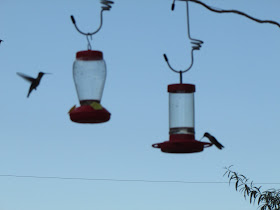Thought I would add a few more hints about feeding hummingbirds. We see more and more of the tiny birds at the feeders because there are fewer and fewer of the wild flowers that the birds always got their nectar from before. One of the best ways to attract hummers to your yard is to plant flowers and scrubs that will draw the hummers in. I have a hard time keeping the flowers that they like here in the desert. I do grow lots of morning glories. The birds go to the big blue and pink blossoms but I don't think they get much from them. The same can be said for both the tame and the wild sunflowers we have. The birds go to the zinnias but don't seem to like what they find. One of the best plants for attracting hummers are trumpet vine. Most of these vines are orange but some are more red and some are yellow. It doesn't seem to matter what color they are. The birds like them and they are easy to grow. (except in my yard). Another favorite of the hummers are butterfly bushes and bottlebushes. Other plants are bee balm, honeysuckle, sage, red hot pokers, desert willow, and poinseina or bird of paradise. Also salvias, yuccas, and daylilies.
So since there are fewer and fewer flowers for the birds we need to feed them so they are fat enough and healthy enough to make the migration to Central and South America for the winter. In hanging the feeders I have found several problems. Ants are one of the worst problems. It seems like regardless where I hang my feeders they ants find them. I have learned the best thing is simply to move the feeder to a different place when you find the feeder full of ants. I mostly hang the feeders on tree branches that I can reach. Any time I see ants in a feeder I empty and clean and refill it and hang it in a different tree. You can try a different branch in the same tree but the ants will find it sooner. Another way to keep the ants out is to put something like a cheep mentholatum or vicks around the base of the tree or on the bottom part of a metal pole if that is what you are using. (this can also help with squirrels, or those large termites that eat fence posts that are better known as horses or ponies.)
Another problem can be bees and wasps. The hummers don't like them and will try to chase them off. Usually it's not that bad a problem here and I can tolerate the stingers. If you don't really bother them they usually won't bother you. If you swat at them and swing your hands and arms around they are more apt to get upset and sting. I got stung this year by a small bee for the first time in many years and I am not sure what I did to upset the bee. When changing out the feeders is usually when you will encounter the bees the most. One way to get around that is to change out the feeders in the evening after dark. Bees and birds will have gone to bed by then. I do this as often as I can remember to do it.
If anyone has other tricks or hints for carring for these tiny, wonderful little birds I would be interested to hear them.









































